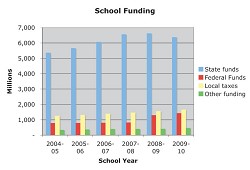
King County Superior Court Judge John Erlick recently ruled that the legislature is in violation of Article IX section 1 of the Washington State Constitution to provide state funding for public schools. That section states, “It is the paramount duty of the state to make ample provision for the education of all children residing within its borders, without distinction or preference on account of race, color, caste, or sex.” Judge Erlick left it up to the legislature to resolve the problem of how to address their constitutional responsibilities. But with the current legislative session scheduled to end this week, it is still unclear that anything will be done this session to address the Judge’s decision.
Faced with a $2.8 billion budget deficit, no proposals are on the table that would increase school funding. The question is how much more will be cut from the states already inadequate level of funding for basic support of education as required by the state constitution. According to the Office of the Superintendent of Public Instruction’s web site, at this writing, Governor Gregoire’s proposal would cut approximately $500 million, the Senate would cut slightly more than $1.2 billion and the House would cut about $750 million in state support. The final cut will have to be reconciled, but in view of the Judge’s decision it would appear none of these proposals will do anything to resolve the Judge’s concerns.
Governor Gregoire says she has a lot of questions about Judge Erlicks’s decision and is undecided about whether she will appeal the decision. But while state political leaders postpone addressing the issue, local school districts continue to struggle with increasing costs and declining revenue. In North Central Washington our local school districts face state budget funding cuts from nearly $1 million in Cashmere, Brewster, Bridgeport and Tonasket to $250,000 to $300,000 in Leavenworth, Lake Chelan, Manson, Entiat, Pateros and Oroville.
Most education groups are hailing the judge’s decision as a mandate for the state to increase funding for local schools, but just increasing funding ignores the issues of a fundamentally flawed budgeting system and out of control spending.
Over the last five years the total revenue budget for education has increased 28 percent while expenditures have increased 30 percent. Put another way the state has increased its spending on education by $131 million more than it has increased the funding for that education. And the state’s portion of that revenue budget has only increased 19 percent over those same five years. The result is local school districts have been forced to raise more funds locally and rely on increasing contributions from the Federal government to fund the local schools.
Statewide expenditures for public schools have increased at twice the rate of inflation plus the increase in the number of students over the last five years. To put this in perspective, if schools could have maintained their spending levels at the general level of inflation as measured by the national consumer price index (CPI) plus the increase in student enrollment, the total operating expenditures for state education would be $3.3 billion dollars less this year than what the state is currently projecting. In other words – the state would have no budget shortfall.
How much control local school districts have over their budgeted expenditures is also a matter of significant debate. For example, teacher salaries are set by the state in negotiation with the teacher’s union. And state law requires those salaries be the same across the state regardless of the cost of living in individual districts. Over the last four years teacher salaries have increased by a little over 14 percent while general inflation increased 10 percent over the same period. Also state mandated employee benefit costs have increased from 28 percent of payroll to 33 percent of payroll. Wages and benefits make up 80 percent of school budgets statewide.
Schools are not the only government program facing the knife in Olympia and cutting through the political fog to understand the issue is not easy. Judge Erlick has stated that current elected officials have violated their constitutional responsibility. What is not clear is whether they can fix the problem by cutting costs, reallocating state resources or will they be required to raise taxes to provide new funding for education.






